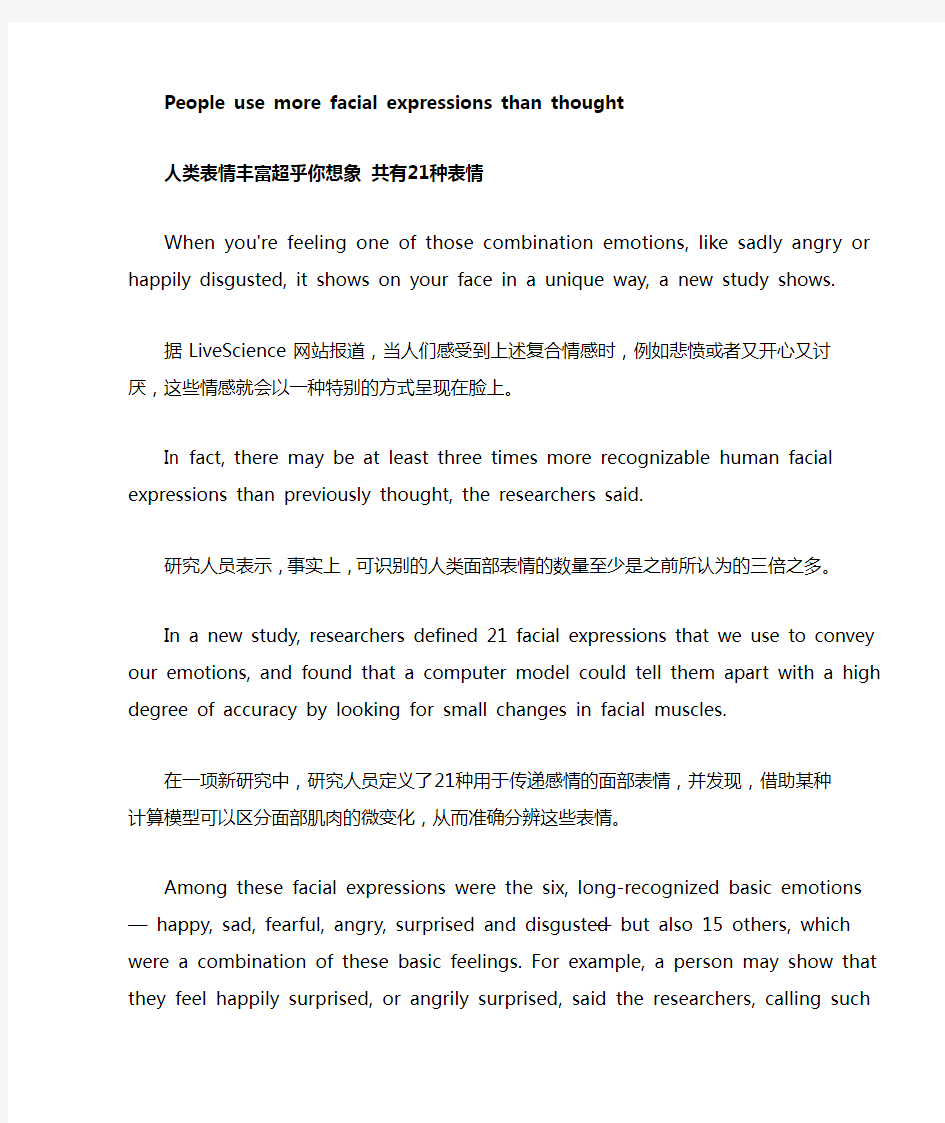人类表情丰富超乎你想象 共有21种表情

- 1、下载文档前请自行甄别文档内容的完整性,平台不提供额外的编辑、内容补充、找答案等附加服务。
- 2、"仅部分预览"的文档,不可在线预览部分如存在完整性等问题,可反馈申请退款(可完整预览的文档不适用该条件!)。
- 3、如文档侵犯您的权益,请联系客服反馈,我们会尽快为您处理(人工客服工作时间:9:00-18:30)。
People use more facial expressions than thought
人类表情丰富超乎你想象共有21种表情
When you're feeling one of those combination emotions, like sadly angry or happily disgusted, it shows on your face in a unique way, a new study shows.
据LiveScience网站报道,当人们感受到上述复合情感时,例如悲愤或者又开心又讨厌,这些情感就会以一种特别的方式呈现在脸上。
In fact, there may be at least three times more recognizable human facial expressions than previously thought, the researchers said.
研究人员表示,事实上,可识别的人类面部表情的数量至少是之前所认为的三倍之多。
In a new study, researchers defined 21 facial expressions that we use to convey our emotions, and found that a computer model could tell them apart with a high degree of accuracy by looking for small changes in facial muscles.
在一项新研究中,研究人员定义了21种用于传递感情的面部表情,并发现,借助某种计算模型可以区分面部肌肉的微变化,从而准确分辨这些表情。
Among these facial expressions were the six, long-recognized basic emotions —happy, sad, fearful, angry, surprised and disgusted —but also 15 others, which were a combination of these basic feelings. For example, a person may show that they feel happily surprised, or angrily surprised, said the researchers, calling such feelings compound emotions.
这些表情中,最早为人所知的六种基本情感分别是,喜悦、悲伤、害怕、愤怒、和厌恶。另外15种则是这些基本情感的组合。例如,某人可能表现出惊喜,或
者惊怒。研究人员将其统称为复合情感。
This extended library of facial expressions of emotions may be useful in studying human brain and social communication, as well as in the design of computer systems that can communicate with humans, researchers said in their study published today (March 31) in the journal Proceedings of the National Academy of Sciences.
3月31日发表在美国国家科学院院刊上的报告显示,对情感投射的面部表情进行
这样的词汇扩充,有助于人脑和社会交流的研究工作、以及与人类交流的计算机
系统的设计工作。
"We've gone beyond facial expressions for simple emotions like 'happy' or 'sad.' We found a strong consistency in how people move their facial muscles to express 21 categories of emotions," said study researcher Aleix Martinez, a cognitive scientist and associate professor of electrical and computer engineering at The Ohio State University. "That tells us that these 21 emotions are expressed in the same way by nearly everyone, at least in our culture." “人类的面部表情早就不局限于表达像喜悦或者悲伤这样的简单感情了。我们发
现,人们在运用面部肌肉表达21种表情时具有高度的一致性。”研究者亚历克
斯·马丁内斯介绍说。他是俄亥俄州立大学电子与计算工程专业的副教授,也是
一位认知学家。他说:“研究结果告诉我们,每个人在表达这21种情感时几乎
使用同一种方式,至少在我们的文化中是这样的。”
Historically, scientists and philosophers have focused their studies on six basic emotions, but deciphering a person's brain functioning with only six categories is like painting a portrait with only primary colors, Martinez said in a statement.
历史上,科学家和哲学家们都将研究重点放在六种基本情感上。但仅仅利用这六
种类型就想弄清楚人脑功能是不可能的,就好比只用基本色绘制肖像画。马丁内
斯评论说。
